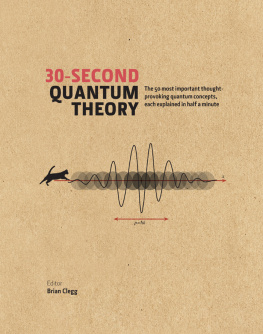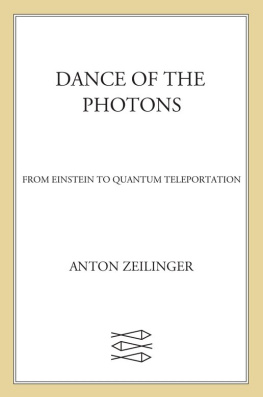
The author and publisher have provided this e-book to you for your personal use only. You may not make this e-book publicly available in any way. Copyright infringement is against the law. If you believe the copy of this e-book you are reading infringes on the authors copyright, please notify the publisher at: us.macmillanusa.com/piracy.
CONTENTS
TO GILLIAN, REBECCA, AND CHELSEA
PREFACE
If you thought science was a predictable, commonsense businessmaybe even a little dullyou havent encountered quantum entanglement. A physical phenomenon so strange and all pervasive that this book calls it the God Effect, entanglement leaves common sense shattered. Inexplicable in normal terms, entanglement can reach instantaneously from one end of the universe to the other. Speculatively cited as the source of life and the mechanism of the mysterious Higgs boson, aka the God particle, entanglement has powerful potential uses from unbreakable encryption to teleportation. Its the strangest effect in all of science, yet hardly anyone has heard of it.
Once upon a time, science seemed straightforward. The British professor of natural history Thomas Huxley, whose support for evolution in the second part of the nineteenth century gained him the nickname Darwins Bulldog, described science as nothing but trained and organized common sense. Yet the changes in science, and particularly physics, in the following century would prove him startlingly wrong.
Take quantum electrodynamics, the theory explaining the interaction of matter and light. This is how it was described in an open lecture by Richard Feynman, the brilliant twentieth-century American physicist whom many would consider one of the few true geniuses to flourish in the scientific community. (If youve never heard Feynman speak, imagine Tony Curtis reading these words):
The theory of quantum electrodynamics describes Nature as absurd from the point of view of common sense. And it agrees fully with experiment. So I hope you can accept Nature as She isabsurd.
Im going to have fun telling you about this absurdity, because I find it delightful. Please dont turn yourself off because you cant believe Nature is so strange. Just hear me out, and I hope youll be as delighted as I am when were through.
The topic of this book, quantum entanglement, takes the absurdities and delights that inspired Feynman to a new level. Entanglement is remarkable in its own right, but even more amazing are the recent discoveries of real-world applications for this strange effect. Be prepared to encounter surprise and wonder.
GOING FURTHER
Quantum entanglement, is at the time of writing a field in furious development. There are new discoveries on an almost weekly basis. If you would like to read further, visit the Popular Science Web site, www.popularscience.co.uk, for features on the developing story of entanglement and recommendations of other books with which to explore the quantum world and the wider bounds of science and mathematics.
I have avoided reference numbers in the text to avoid breaking the flow, but the endnotes section, starting , gives detailed references for quotes, sources, and papers to help with further reading.
A NOTE ABOUT ALICE AND BOB
There is a long-standing convention among scientists dealing with quantum entanglement to refer to the owner of one end of an entangled process as Alice and the person at the other end as Bob. Usually Alice is trying to send Bob a message in this inane little drama.
The convention derives from cryptography, where the same names (along with other bit-part players, such as the eavesdropper, Eve) have been used in these roles for a good number of years. While the true origins of the names are lost in the mists of time, and they were obviously dreamed up to give more meaningful labels to a geometry diagrams dull point A and point B, its hard for anyone of the right age to hear Bob and Alice without remembering the now very dated 1969 film Bob & Carol & Ted & Alice and wincing.
Where a convention has practical value it is worth maintaining, but Alice and Bobs role in entanglement is purely habitual and conveys nothing worthwhileso to spare the pain of remembering the movie they will not appear again in this book.
CHAPTER ONE
ENTANGLEMENT BEGINS
Laws are generally found to be nets of such a texture, as the little creep through, the great break through, and the middle-sized are alone entangled in.
WILLIAM SHENSTONE , Essays on Men, Manners, and Things
Entanglement. Its a word that is ripe with implications. It brings to mind a kitten tied up in an unraveled ball of wool, or the complex personal relationship between two human beings. In physics, though, it refers to a very specific and strange concept, an idea so bizarre, so fundamental, and so far reaching that I have called it the God Effect. Once two particles become entangled, it doesnt matter where those particles are; they retain an immediate and powerful connection that can be harnessed to perform seemingly impossible tasks.
The word quantum needs a little demystifying to be used safely. It does nothing more than establish that we are dealing with quanta, the tiny packets of energy and matter that are the building blocks of reality. A quantum is usually a very small speck of something, a uniform building block normally found in vast numbers, whether its a photon of light, an atom of matter, or a subatomic particle like an electron.
Dealing in quanta implies that we are working with something that comes in measured packages, fixed amounts, rather than delivered as a continuously variable quantity. In effect, the difference between something that is quantized and something continuous is similar to the difference between digital information, based on quanta of 0s and 1s, and analog information that can take any value. In the physical world, a quantum is usually a very small unit, just as a quantum leap is a very small changequite different from its implications in everyday speech.
The phenomenon at the heart of this book is a linkage between the incomprehensibly small particles that make up the world around us. At this quantum level, it is possible to link particles together so completely that the linked objects (photons, electrons, and atoms, for instance) become, to all intents and purposes, part of the same thing. Even if these entangled particles are then separated to opposite sides of the universe, they retain this strange connection. Make a change to one particle, and that change is instantly reflected in the other(s)however far apart they may be. The God Effect has an unsettling omnipresence.
This unbounded linkage permits the remarkable applications of quantum entanglement that are being developed. It enables the distribution of a secret key for data encryption that is impossible to intercept. It plays a fundamental role in the operation of a quantum computera computer where each bit is an individual subatomic particle, capable of calculations that are beyond any conventional computer, even if the program ran for the whole lifetime of the universe. And entanglement makes it possible to transfer a particle, and potentially an object, from one place to another without passing through the space in between.
This counterintuitive ability of entanglement to provide an intimate link between two particles at a distance seems just as odd to physicists as it does to the rest of us. Albert Einstein, who was directly responsible for the origins of quantum theory that made entanglement inevitable, was never comfortable with the way entanglement acts at a distance, without anything connecting the entangled particles. He referred to the ability of quantum theory to ignore spatial separation as spkhafte Fernwirkungen, literally spooky or ghostly distant actions, in a letter written to fellow scientist Max Born:
Next page














